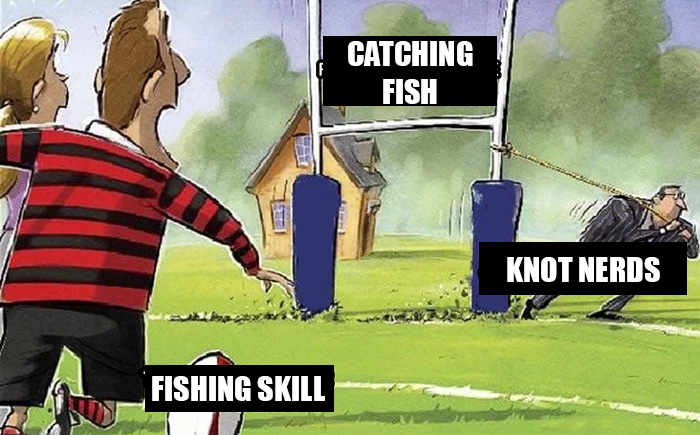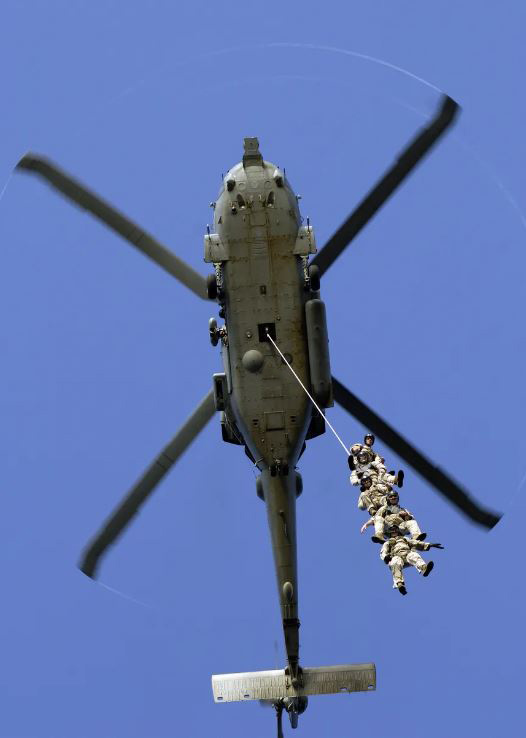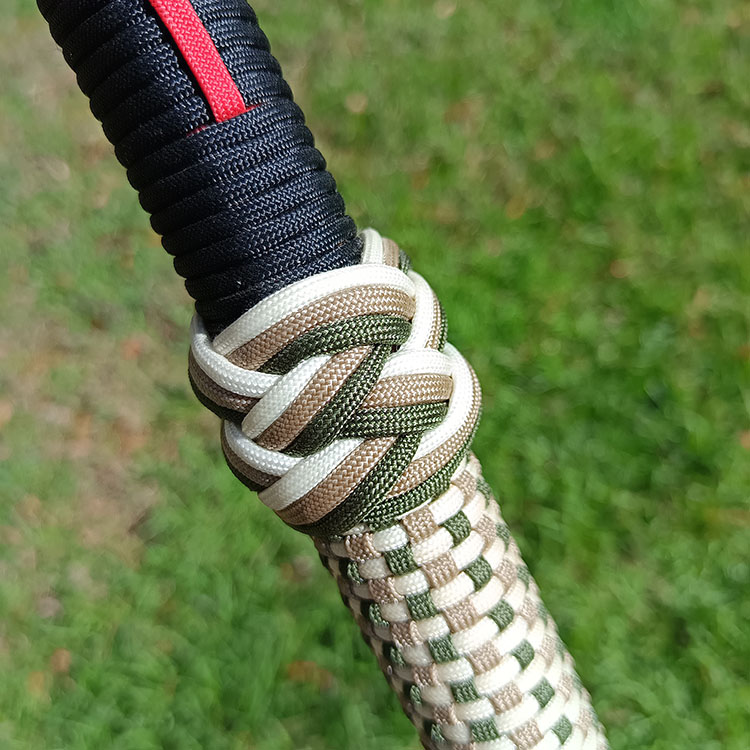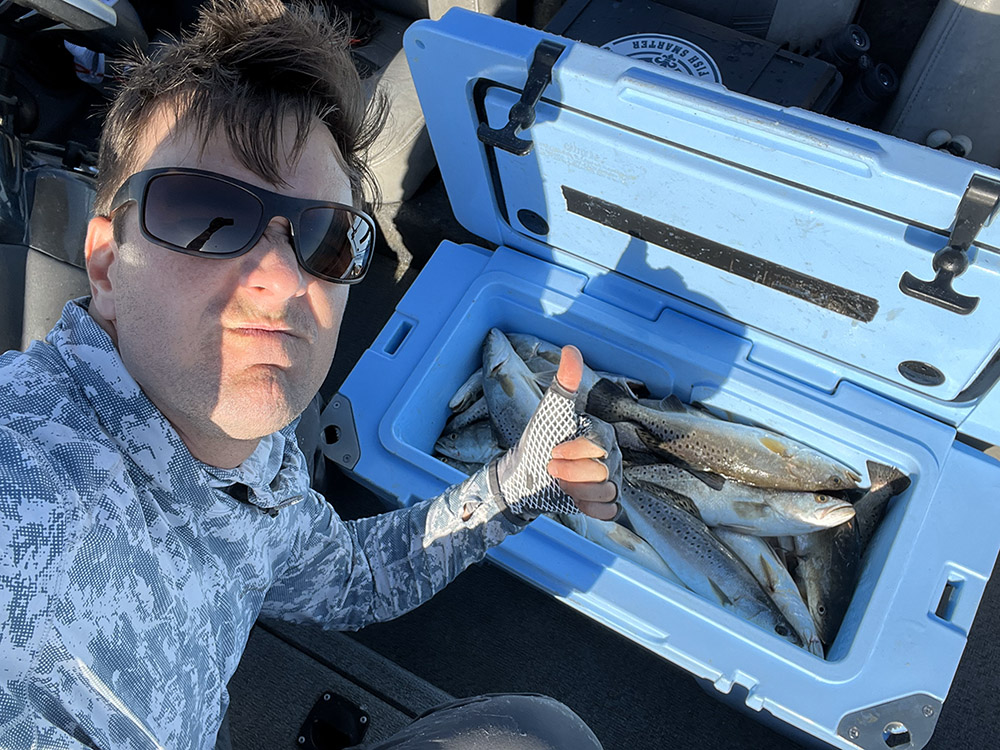Knot nerds absolutely ruin fishing, mostly because they move the goat post to where it doesn't matter:
But what is a "knot nerd"? Why am I even bringing this up to begin with? Most important: what actually matters in fishing? This and more is what I'll detail in today's guide. I'll begin with this inflammatory statement:
Tying knots is not as important as you've been led to believe...
If you've been visiting my website and YouTube channels for awhile then you may have noticed that I really don't cover knots. In fact, I've never written or filmed a single guide to tying knots (outside of a very brief and to-the-point tutorial inside Inshore Fishing 101).
This is for a couple reasons: anything and everything you need to know about knots is already covered extensively elsewhere, whether that is in a dedicated knot book or any of the thousands of videos and tutorials on the Internet. It’s a safe observation that the topic of knot tying is absolutely beat to death. That, and it’s a topic that easily distracts from the entire purpose of using knots in the first place: to go catch a dang fish.
I’ll be honest, I think some people can’t catch fish as well as they’d like the public to believe, so they move the goal-post to knot tying in an effort to compensate. I call these poor souls “knot nerds”. Which is fine, they can do whatever they want with their free time.

But, where this becomes an issue is that there’s only so much depth to tying a knot for fishing. So, entire videos are published to YouTube hemming and hawing over the strength of one knot or another, and now people are arguing that this knot retains 85% of the line’s strength versus the 90% of this other knot and it’s all just ridiculous because they’re splitting hairs that don’t need to be split.
Read this carefully: I have professionally tied knots for things far more important than catching fish. Knot tying in a place where the consequences are much more dire than losing a lure. I’ve tied everything from Swiss Seats used for rappelling down buildings and SPIE insertions from a helicopter. Yeah, if those fail, you're getting your balls crushed or, even worse, falling to your death.

I've also tied extremely complex knots like Turks Heads and decorative wraps that are meant to stay in place for decades if not forever. In fact, I recently had the pleasure of seeing a paddle I wrapped for a particular Bulk Fueler and am happy to report that — twenty years later — the cord is still intact and tight. Hmmmm, it's almost like I've had some experience tying knots. Yet I avoid being a knot nerd.

I didn't tie this knot, but taught the guy who did. It's still tight and presentable twenty years later!
So which knots actually matter?
So, with that in mind, of all the things I give attention to on a fishing trip, tying a knot is one of the least. You only need to know how to tie a handful and tie them well.
If I could list off a handful of knots that actually matter they would include, but are not limited to:
That's it!
You should be comfortable tying those knots and practice tying them until doing so becomes second nature.
Otherwise, everything else you find in my content are the tough things not everyone knows how to do. Things like finding biting fish in the first place. Let me make some recommendations:
Focus on These Skills Instead of Knot-Nerdery
The very first thing you need to get good at is properly judging the conditions. While there are many, I advise you learn to judge the wind first. This guide details how I use Windfinder to that end.
Next, I strongly recommend learning how to position your boat according to the wind, maximize the number of anglers fishing with you and selecting the best sinking weight. This free video course details exactly how to do that.
Lastly, you will need to be familiar with white PVC poles. They are used for marking safe routes and underwater hazards, but how do you tell them apart? This guide tells you what to look for. This way you can safely get to your fishing spots and back to the dock, without damaging your boat or worse.

Do you want to catch limits of fish? Yes? Then focus on what matters with the limited time you have.
Where to get more fishing knowledge...
While you'll find a lot of content here and on my YouTube channel detailing knowledge like what's linked above, you will find all of them in one place in my course Inshore Fishing 101 and the accompanying seasonal courses. The finishing touch is LAFB Elite's Community for reading detailed fishing reports and getting help planning your fishing trip (using what's taught inside 101, of course).
”
One think I loved discovering inside Inshore Fishing 101 are the various tips and tricks to using Google Earth Desktop to find fishing spots.
I have used it a lot in the past but applying it the way Captain Devin demonstrates is great. I also loved the instruction on bait presentation and how to set up on a spot.
Jacob Ridgedell / Avid Outdoorsman
”
I'm a recent transplant from north Louisiana, and most of inshore fishing is brand new to me. I bought a boat last year and made a vow to learn as much as I can about the marsh, and feel like I've done just that!
I've bass fished a good bit so I have some basic knowledge and have been able to catch fish every time I've gone, just not numbers. I feel that this is taking me to the next level.
Time to catch a limit!
Steven Hinton / Construction
”
Devin's courses are easy to watch, and the delivery of each point in his lessons come naturally.
No one has a course like Inshore Fishing 101 that is more complete when it comes to speckled trout and redfish here in the state of Louisiana.
Brandon Robichaux / Rigolets Area Angler
”
I learned that I couldn't see the marsh for the bayou. What I mean by that is I was unknowingly doing a lot of things wrong with poor results and just chalked it up to a bad day of fishing. Devin presents a ton of concepts that the average fisherman either overlooks, isn't executing properly or is flat out ignorant of.
Inshore Fishing 101 isn't just a bunch of random tips! It is an intricate web of interconnected actions, equipment, locations, biology, conditions, techniques, technology, and experience that come together to give you the best chance of filling the box with fish on a consistent basis.
He shows how simple it is: you don't need a 24 ft bay boat, you don't need 500 different color lures, you don't need the most expensive gear, all you need to is a rod, a reel a lure and a little moving water, clean water and lots of bait in the area.
Randy Ahrabi / Small Business Owner
What do you think about knot nerds?
Am I on to something here or am I just being arrogant? What knots do you prefer? Is my above list complete enough for Louisiana's inshore angler or is there something I'm missing?
I love it when people take time to comment on my website, so if you have something to add then please do so below.
Tight lines, and thanks for visiting!

I agree Devin. Your list is all an angler should need.
I agree 100%. I tie 4 knots 99.9% of the time. Uni-uni, uni, and loop knot with occasional improved clinch. Simple, fast, dont have to think to hard, and works for everything in my tackle bag.
I couldn’t agree with you more. But I submit if you are worried about knot strength, you might want to think about why reels have drags.